 Now that Allen Johnson is entering the twilight of his career, the time has come to start thinking about who the next great American high hurdler will be. The history of American distinction in this event dates back to the early part of the twentieth century, and has been continued generation after generation. From Forrest Towns to Bill Porter to Harrison Dillard (pictured left) to Jack Davis to Lee Calhoun to Hayes Jones to Willie Davenport to Rodney Milburn to Renaldo Nehemiah to Greg Foster to Roger Kingdom to Allen Johnson, the United States has set the standard for excellence in the high hurdles throughout the world since the inception of the event. With the exception of the U.K.’s Colin Jackson in the 1990’s, no non-American hurdler has ever stood head and shoulders above the rest of the hurdling world. Until now.
Now that Allen Johnson is entering the twilight of his career, the time has come to start thinking about who the next great American high hurdler will be. The history of American distinction in this event dates back to the early part of the twentieth century, and has been continued generation after generation. From Forrest Towns to Bill Porter to Harrison Dillard (pictured left) to Jack Davis to Lee Calhoun to Hayes Jones to Willie Davenport to Rodney Milburn to Renaldo Nehemiah to Greg Foster to Roger Kingdom to Allen Johnson, the United States has set the standard for excellence in the high hurdles throughout the world since the inception of the event. With the exception of the U.K.’s Colin Jackson in the 1990’s, no non-American hurdler has ever stood head and shoulders above the rest of the hurdling world. Until now.
With Liu Xiang of China having won the Olympic gold medal in 2004, and with Ladji Doucoure of France having won the World Championship gold medal in 2005, it has become quite obvious that American dominance in the 110 meter high hurdles has come to an end. At the very least, it has been put on lengthy pause. An American has not won an Olympic or World Championship gold medal since Johnson did so in 2003. If you take Johnson out of the equation, no American has won a major meet gold medal since Greg Foster’s World Championship victory in 1991. Although, to be fair, Mark Crear’s second-place finish at the 1996 Olympics proves that if Johnson hadn’t won the gold, Crear would have. Still, it cannot be denied that the rest of the world has caught up to the United States when it comes to the high hurdles. With Xiang and Doucoure both being in their early twenties, it could very well play out that those two end up dueling for high hurdling supremacy throughout the next eight to ten years or so. Both of these athletes have run under 13.00, and have run consistently under or right at 13.10. Except for Johnson, there are no Americans about whom both statements can currently be said.
Personally, the fact that the gold medals have been lacking of late doesn’t bother me all that much. American hurdlers have been very competitive, the races have been fun to watch, and, really, good hurdling is good hurdling, no matter what color the uniform is of the athlete running the race. Even in the previous lean years – 1992-1993 – when Canada’s Mark McKoy won the Olympics followed by Jackson emerging victorious with a new world record in the World Championships, Americans Tony Dees and Jack Pierce were right there in the mix, so there was no reason to go around looking for panic buttons to push. Neither should there be now, because there are plenty of American hurdlers on the scene who have yet to reach their potential and have a good chance of making significant international impact in the coming years. Besides the obvious names of Johnson, Dominique Arnold, and Terrence Trammell, here are some of the younger American hurdlers who could make some noise in 2007, 2008, and beyond:
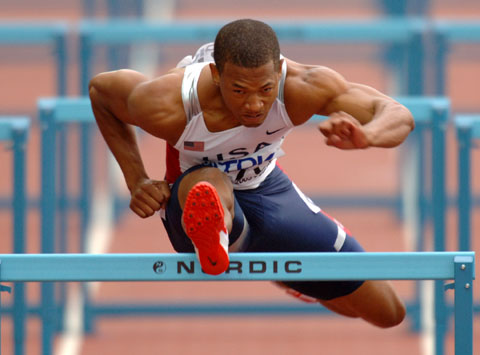 Joel Brown
Joel Brown
This 25-year-old graduate of Ohio State University won two consecutive Big 10 championships in his last two years as a collegian, and has since made significant strides in the past two years. In 2004, he finished third at the NCAA Outdoor Championships in 13.35, and finished fifth in a semi-final heat at the Olympic Trials in 13.39. In 2005, he finished fourth at the USA Outdoor Championships in 13.28, and finished the year with a personal best of 13.22 that he ran at the Oslo meet in Norway. You’ve gotta figure that if Brown can get down into the 13.10 range in 2006, he’ll be one of the major contenders in Japan in 2007.
 Ron Bramlett
Ron Bramlett
The 26-year-old Bramlett, whose personal best is a 13.26 that he ran at Lausanne in 2004, has been knocking on the door of hurdling greatness for a few years now. A two-time NCAA Outdoor champion (2001-02) while at the University of Alabama, Bramlett had somewhat of a down year in 2005, as he only finished ninth at the USA Outdoor Championships. Still, Bramlett’s is a name to look out for. If he keeps his confidence up and smooths out whatever technical flaws he feels he has, there’s no reason he can’t compete on the level of a Johnson, Arnold, or Trammell.
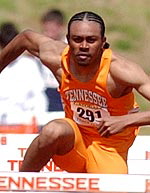 Aries Merritt
Aries Merritt
Merritt, who just finished his second year at the University of Tennessee, has already established himself as one of the best hurdlers in the U.S., and he still has much room for growth. After finishing fourth in the NCAA Outdoor Championships as a freshman in 2004 in a time of 13.47, Merritt, in 2005, won the 110’s in the ultra-competitive SEC Conference in 13.38. At the USA Outdoor Championships, he made the finals, and went on to finish seventh in 13.39. With his youth and potential for growth, there can be no doubt that Merritt has what it takes to become the next American high hurdling great.
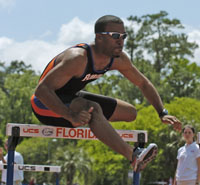 Joshua Walker
Joshua Walker
In 2005, Walker, of the University of Florida, won his second consecutive NCAA Outdoor championship in 13.32 – the exact same time in which he won the 2004 championship. He has struggled, however, at the USA Outdoors the last two years. Still, Walker is one of the finest technicians hurdling today. With his very fluid, rhythmic hurdling style, one would have to believe that, once free of the constraints of the collegiate schedule, Walker will break into the next level of elite hurdling in the next couple years.
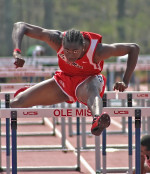 Antwon Hicks
Antwon Hicks
Hicks, a recent graduate of the University of Mississippi, finished second to Walker at the 2005 NCAA Outdoor Championships in a time of 13.42. He then went on to set a personal best at the USA Outdoor championships, finishing sixth in the finals in a time of 13.35. As with Merritt and Walker, Hicks’ youth and progress up to this point bode well for the future.
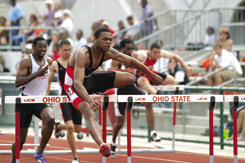 David Payne
David Payne
Payne, who graduated from the University of Cincinnati in 2004, made notable progress in 2005, his first year as a post-collegian, dropping his personal best down from 13.48 all the way down to 13.33 – which he ran at the USA Outdoor Championships, earning himself a fifth-place finish, only one spot away from making the World Championship team, as Allen Johnson had an automatic bye. Similar to the aforementioned hurdlers, once you hit that 13.30 range, the 13.10 range isn’t that far away. With two years to go before the next World Championships, Payne could be right there if he continues to improve the way he has over the past couple years.
The men’s high hurdles is an event that takes a long time to get the hang of. Rare are the athletes who can pick up right where they left off while running over the 39-inch hurdles as prep athletes. The Renaldo Nehemiahs and Greg Fosters of the world are the exceptions, not the rule. So are the Liu Xiangs and Ladji Doucoures. If the hurdlers I’ve discussed in this article continue to work hard in their efforts to master this most difficult of technical events, then, even if they don’t necessarily come back from foreign lands with gold medals in their hands, they will still be able to continue the legacy established in previous decades of the United States being one of the best hurdling countries in the world. In addition, I’m sure there are several other hurdlers out there whom I didn’t mention who may surge to the forefront. For all we know, the next great American high hurdler might still be in high school.
© 2005 Steve McGill
